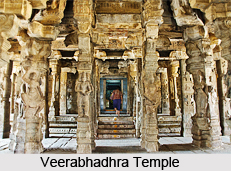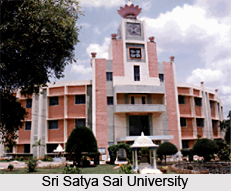 Religious monuments in Anantpur district offers a pleasant ride as the district has a lot to offer. A number of historical and religious monuments are found dotting the landscape of the place. The major monuments of religious interest are discussed below.
Religious monuments in Anantpur district offers a pleasant ride as the district has a lot to offer. A number of historical and religious monuments are found dotting the landscape of the place. The major monuments of religious interest are discussed below.
Lepakshi is the most important place in the Anantpur District from the religious as well as historical perspective. Lepakshi is situated at a distance of km from Bangalore and 110 km from Anantapur. Lepakshi is well connected by road with frequent bus and private transport facilities from Hindupur at the distance of 15 KM. The nearest railhead is at Hindupur.
The Skandhapuranam refers to Lepakshi as one of the 108 Saiva temples in India. Sri Virupanna, who worked as a Treasury Officer of Penukonda Fort of Vijayanagara Empire, took up the construction of the Lord Veerabhadhra Temple at Lepakshi in the 16th-century (1538 A.D.). One can find the late Vijayanagara style of architecture in the vestiges of Lepakshi. The natyamandapa or dance hall is supported by 100 pillars finely sculpted with figurines of a dancing Siva, Nandi, Tumbura, Rambha and other celestial beings playing the drum, veena and other instruments in accompaniment. The unfinished Kalyanamandapa on the other side contains sculptures of dikapalakas on the pillar.
From the centre of the mandapa emerges a dome, twenty-one feet high, like a great lotus of heaven. In this huge mandapa, the ceiling is divided into different panels by beams that are painted with some of the most exquisite murals of the Deccan.
A number of monuments of religious interest are found in and around the town of Tadipatri. Tadipatri is Located at a distance of 90kms, from Anantapur. In the heart of the town is the Chintala Venkataramana Temple with its lofty gopura. At a distance of 1km, from the town, overlooking the Pennar River is the Bugga Ramalingeshwara Temple, remarkable for a lingam on a pedestal, constantly filled with water from a small spring. Located a little distance away from the tadipatri is the Aluru Kona village. Found here is the Ranganathaswami temple, built atop a hill. It was constructed by a representative of King Bukkaraya in 1334 AD. Small waterfalls are found in the area where water is ever present.
Another religious monument, the Sri Lakshmi Narasimha Swamy Temple is found located at Penne Ahobilam. Located at a distance of 12kms, from Uravakonda and 36kms, from Anantapur, it is well-linked by road with frequent bus service. This Temple is located amidst lush greenery, on the banks of a rivulet of Pennar. Myth has it that this temple was built on the footprint of Lord Lakshmi Narasimha Swamy measuring 5 feet 3 inches. And it is said that another footprint of the Lord is at the Ahobilam temple in Kurnool district. According to the sources available, Most of the people visit this place to perform marriage ceremonies of their children and relatives. A grand car festival is conducted in the month of April.
 A popular place of pilgrimage is the Sri Lakshmi Narashimha Swami Temple. The epics say that `Narashimha Swami` is one of the ten avataras of Lord Vishnu. It is believed that Narasimha Swami chose to settle down here after killing Hiranyakasipu. This Vishnu temple appears to have been constructed by one `Ranganayudu`, a Palegar of Patharlapattanam. Several scenes from the Ramayana are depicted on the ceiling of the Rangamandapa and several frescos on that of the Lakshmi mandapa depicting scenes from the `Bhagavata`. Many inscriptions on the temple mostly mention the gifts given by kings to the temple.
A popular place of pilgrimage is the Sri Lakshmi Narashimha Swami Temple. The epics say that `Narashimha Swami` is one of the ten avataras of Lord Vishnu. It is believed that Narasimha Swami chose to settle down here after killing Hiranyakasipu. This Vishnu temple appears to have been constructed by one `Ranganayudu`, a Palegar of Patharlapattanam. Several scenes from the Ramayana are depicted on the ceiling of the Rangamandapa and several frescos on that of the Lakshmi mandapa depicting scenes from the `Bhagavata`. Many inscriptions on the temple mostly mention the gifts given by kings to the temple.
Puttaparthi, now popularly known as Prasanthi Nilayam, the abode of Supreme Peace, is the home town of Bhagawan Sri Satya Sai Baba and it is about 40 km away from Dharmavaram, 80 km from Anantapur and 200 km from Bengaluru. He is considered the incarnation of Sri Shirdi Sai Baba and thousands of devotees and tourists from the four corners of the world visit Puttaparti just to have his `darshan`. Places of importance here are Prashanti Nilayam, Purnachandra auditorium, Planetarium, Super speciality hospital, museum and Sri Satya Sai University.
In order to quench the thirst of the villages in the district, Bhagawan Satya Sai Baba conceived a scheme for supply of drinking water at a cost of crores of rupees. Under this, schemes have been established for community protected water supply plans and independent protected water supply plans. The Board of Satya Sai Water Supply Plan, established by the State Government, is vested with authority to oversee everything.
Apart from the above mentioned monuments of religious interest, a number of other monuments are also found at Anantpur district, such as the Yogi Vemana samidhi and the Yadiki caves.
Famous for the Yogi Vemana Samadhi, Kattarupally attracts a lot of pilgrims. Situated 25 kms from Kadiri enroute Thimmamamarimanu, the journey offers spectacular views of rock formations of various shapes. Yogi Vemana is widely known as peoples` poet.
Yadiki is midway between Gooty and Tadipatri. The cave system is in the picturesque village of Konapulappadu which is 18 kms from Yadiki. The magnificent view of the hillocks, gorges, spring, paddy fields, lake and winding roads enthrals every visitor. One of the caves, Geemanugavi, is 5 kms in length. The intricate designs of the stalactite and stalagmite formations take the shape of chandeliers, bridges, globes, snakes etc. The sight of some, which glitter like diamonds, is amazing. Kona Ramalingeswara temple adjacent to the spring adds to the beauty. There is also scope for trekking and rock climbing for those who are interested.
The above mentioned are therefore the various places of religious interest in and around Anantpur district.






